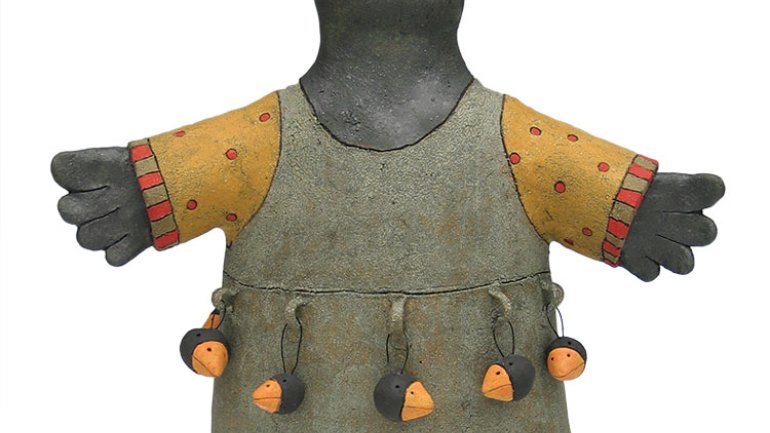The Stories Within
The Stories Within
In her measured creation of colorful figures and forms, sculptor Sara Swink coaxes deeper meaning out of clay.
It's a brisk Sunday morning in sculptor Sara Swink's West Linn, Oregon, studio, and the sun streams through a set of glass-paneled doors. Eight students gather around a table, quietly laughing and chatting. Swink approaches them, tea in hand, and they all turn to look at a group of collages and doodles posted on the wall: the fruit of yesterday's labors.
As Swink remarks on how clearly the personality of each individual is already emerging, the conversation turns to the idea of style: how inherent characteristics of even the simplest mark-making can reveal unique tendencies in a burgeoning artist's work. The group nods, makes observations, and explores the significance of the images they see before them. And that easily, class has begun.
The fluid creative process Swink teaches in her two-day workshops at Clay Circle Studio is the same one she follows in her own artmaking. She begins with collage, pulling images from her extensive collection of old National Geographics, then adds doodles and notes in pen or oil pastels. After a collage is complete, she posts it in the studio for days, even weeks, before pulling it apart and reassembling it into a book - a visual diary. To this she adds sketches and more doodles. Next, clay maquettes serve to refine ideas and forms before she moves on to the final sculpture, which, after this long gestation, is a relatively swift part of the process.
Swink has followed this method since 1998, when she studied with ceramic and bronze sculptor Coeleen Kiebert, whose interests include the psychology of creating. Swink finds it ideal for maintaining a steady stream of ideas and imagery. More important, the stages of the process allow unconscious ideas to merge with her conscious shaping of form and surface, giving her a deeper understanding of a piece's significance.
"I'm motivated by psychological understanding, insight, and exploring questions of a spiritual nature," Swink says. "My work reflects where I'm headed emotionally. For many years I used my artmaking to process childhood - and adult - traumas, although not necessarily directly."
Tapping into deep psychological issues does not, however, result in dark, brooding sculpture. And while her work is clearly symbolic, it's not prescriptive. Swink's style is funky and approachable, marked by simplified forms that evoke narratives through a combination of human and animal elements. By layering slightly different hues of underglaze, she achieves rich colors with unusual depth.
Donna Guardino, the owner of Guardino Gallery in Portland, has sold Swink's work since 2008. "The execution of her ideas in clay is remarkable," she says, "but the first thing I noticed was the narrative nature of her work. People are instantly attracted to it."
Swink also sells her sculpture at Hanson Howard, 9th Street, and Oregon College of Art and Craft galleries in her home state, as well as at Mariposa Gallery in New Mexico. At home, she balances her artmaking with welcoming students into her space and teaching those two-day workshops, as well as weekly classes and adult summer camps.
It's not a surprise that Swink shares her method so successfully: Her strength as a teacher lies in her ability to guide people down a path of discovery, free of judgment. Her strength as an artist comes from extending that same freedom to herself.
"Even now, not until I'm building a piece, or often after it's all done, do I understand what it is about psychologically," she says.
Carolyn Hazel Drake, an artist, teaches visual art at Silverton High School near Portland, Oregon.




